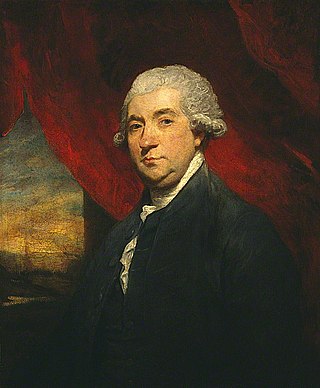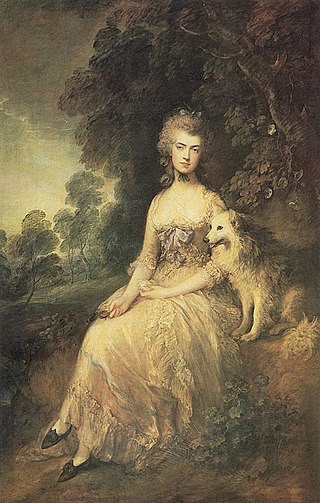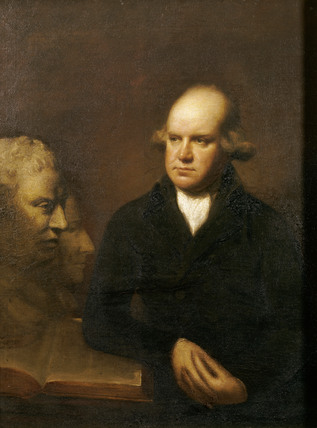Related Research Articles

Laurence Sterne was an Anglo-Irish novelist and Anglican cleric who wrote the novels The Life and Opinions of Tristram Shandy, Gentleman and A Sentimental Journey Through France and Italy, published sermons and memoirs, and indulged in local politics. He grew up in a military family, travelling mainly in Ireland but briefly in England. An uncle paid for Sterne to attend Hipperholme Grammar School in the West Riding of Yorkshire, as Sterne's father was ordered to Jamaica, where he died of malaria some years later. He attended Jesus College, Cambridge on a sizarship, gaining bachelor's and master's degrees. While Vicar of Sutton-on-the-Forest, Yorkshire, he married Elizabeth Lumley in 1741. His ecclesiastical satire A Political Romance infuriated the church and was burnt.

James Boswell, 9th Laird of Auchinleck, was a Scottish biographer, diarist, and lawyer, born in Edinburgh. He is best known for his biography of his friend and older contemporary, the English writer Samuel Johnson, which is commonly said to be the greatest biography written in the English language. A great mass of Boswell's diaries, letters, and private papers were recovered from the 1920s to the 1950s, and their ongoing publication by Yale University has transformed his reputation.

The Gordon Riots of 1780 were several days of rioting in London motivated by anti-Catholic sentiment. They began with a large and orderly protest against the Papists Act 1778, which was intended to reduce official discrimination against British Catholics enacted by the Popery Act 1698. Lord George Gordon, head of the Protestant Association, argued that the law would enable Catholics to join the British Army and plot treason. The protest led to widespread rioting and looting, including attacks on Newgate Prison and the Bank of England and was the most destructive in the history of London.

This article contains information about the literary events and publications of 1796.
This article contains information about the literary events and publications of 1769.
This article contains information about the literary events and publications of 1780.

John Montagu, 4th Earl of Sandwich, PC, FRS was a British statesman who succeeded his grandfather Edward Montagu, 3rd Earl of Sandwich as the Earl of Sandwich in 1729, at the age of ten. He held various military and political offices, including Postmaster General, First Lord of the Admiralty, and Secretary of State for the Northern Department. He is also known for the claim that he was the inventor of the sandwich.

William Henry Ireland (1775–1835) was an English forger of would-be Shakespearean documents and plays. He is less well known as a poet, writer of gothic novels and histories. Although he was apparently christened William-Henry, he was known as Samuel through much of his life, and many sources list his name as Samuel William Henry Ireland.

Michael John Dobbs, Baron Dobbs is a British Conservative politician and author, best known for his House of Cards trilogy.

Edmond Malone was an Irish Shakespearean scholar and editor of the works of William Shakespeare.

Mary Robinson was an English actress, poet, dramatist, novelist, and celebrity figure. She lived in England, in the cities of Bristol and London; she also lived in France and Germany for a time. She enjoyed poetry from the age of seven and started working, first as a teacher and then as actress, from the age of fourteen. She wrote many plays, poems and novels. She was a celebrity, gossiped about in newspapers, famous for her acting and writing. During her lifetime she was known as "the English Sappho". She earned her nickname "Perdita" for her role as Perdita in 1779. She was the first public mistress of King George IV while he was still Prince of Wales.

Philip Dormer Stanhope, 4th Earl of Chesterfield, was a British statesman, diplomat, man of letters, and an acclaimed wit of his time.

Sir Herbert Croft, 5th Baronet, English author best known for his novel Love and Madness.

William Shakespeare's sexuality has been the subject of frequent debates. It is known from public records that he married Anne Hathaway and had three children with her; scholars have examined their relationship through documents, and particularly through the bequests to her in his will. Some historians have speculated Shakespeare had affairs with other women, based on contemporaries' written anecdotes of such affairs and sometimes on the "Dark Lady" figure in his sonnets. Some scholars have argued he was bisexual, based on analysis of the sonnets; many, including Sonnet 18, are love poems addressed to a man, and contain puns relating to homosexuality.

Martha Ray was a British singer of the Georgian era. Her father was a corsetmaker and her mother was a servant in a noble household. Good-looking, intelligent, and a talented singer, she came to the attention of many of her father's patrons. She is best known for her affair with John Montagu, 4th Earl of Sandwich. She lived with him as his mistress from the age of seventeen, while his wife was suffering from mental illness. She gave birth to nine children, five of whom survived, including the lawyer and philanthropist Basil Montagu. During this time, she conducted a successful singing career, for which she became well known, as well as completing her education with Lord Sandwich's support.
"The Shakespeare Code" is the second episode of the third series of the revived British science fiction television series Doctor Who. It was broadcast on BBC One on 7 April 2007. According to the BARB figures this episode was seen by 7.23 million viewers and was the fifth most popular broadcast on British television in that week. Originally titled "Love's Labour's Won", the episode was re-titled as a reference to The Da Vinci Code.

The Ireland Shakespeare forgeries were a cause célèbre in 1790s London, when author and engraver Samuel Ireland announced the discovery of a treasure-trove of Shakespearean manuscripts by his son William Henry Ireland. Among them were the manuscripts of four plays, two of them previously unknown.

James Hackman, briefly Rector of Wiveton in Norfolk, was the man who murdered Martha Ray, singer and mistress of John Montagu, 4th Earl of Sandwich.
Caterina Galli was an Italian operatic mezzo-soprano. She first rose to fame in England in the 1740s and early 1750s where she was particularly admired for her performances in the works of George Frideric Handel. She then enjoyed success in her native country in the 1750s and 1760s, before returning to England, where she remained active as a performer up through 1797.
The Dark Lady is a woman described in Shakespeare's sonnets, and so called because the poems make it clear that she has black wiry hair, and dark, "dun"-coloured skin. The description of the Dark Lady distinguishes itself from the Fair Youth sequence by being overtly sexual. Among these, Sonnet 151 has been characterised as "bawdy" and is used to illustrate the difference between the spiritual love for the Fair Youth and the sexual love for the Dark Lady. The distinction is commonly made in the introduction to modern editions of the sonnets. As with the Fair Youth sequence, there have been many attempts to identify her with a real historical individual. A widely held scholarly opinion, however, is that the "dark lady" is nothing more than a construct of Shakespeare's imagination and art, and any attempt to identify her with a real person is "pointless".